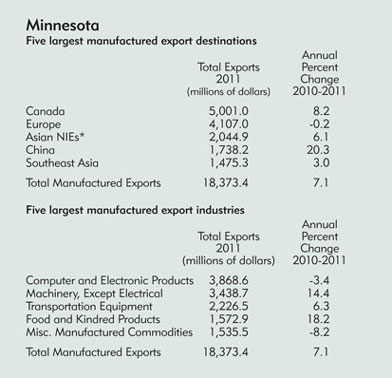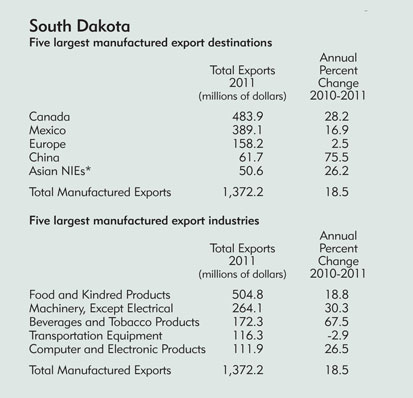The economy of 2011 will go down as somewhat lackluster, but don’t blame manufacturing exports from district states, which increased more than 10 percent last year, reaching a record $43.7 billion. That’s lower than the 17 percent bump in 2010, but the second-best performance since the recession. Manufactured exports increased in all states, with the strongest growth in North Dakota and South Dakota; each increased about 19 percent in 2011.
The global economy continued to expand during 2011, which supported demand for district products. The strongest growth was reported in China, India and other developing nations. Developed countries contributed less to overall global output, as Japan’s economy was weakened by the tsunami and Europe struggled with government debt levels.
Overall, the value of the U.S. dollar relative to foreign currencies remained moderately stable. According to a weighted average of a broad array of foreign currencies, the U.S. dollar increased a bit in value, which generally made U.S. exports abroad slightly more expensive.
However, there was diversity among particular currencies. The U.S. dollar increased in value modestly relative to the euro and Canadian dollar, but more than 10 percent relative to the Mexican peso (see Chart 1). This likely contributed to the largely soft gain in district manufactured exports to Mexico.
Meanwhile, the U.S. dollar decreased in value relative to the Japanese yen and Chinese yuan. Despite the fall in value of the U.S. dollar, district manufactured exports to Japan dropped 1.3 percent in 2011, as the country struggled with the impact of the tsunami. The district’s largest manufactured export industry to Japan, computer and electronic products, decreased by 9 percent, but gains were recorded in machinery and food and kindred products.
Since China allowed the value of the yuan to fluctuate relative to the dollar in July 2005, the U.S. dollar has decreased in value by 24 percent relative to the yuan. U.S. and district manufactured exports to China made strong gains during this time, but are still dwarfed by the value of imports from China, as evidenced by the large U.S.-China trade deficit. Nevertheless, the value of imports relative to exports decreased nationally to a ratio of 4-to-1 in 2011 from 6-to-1 in 2005.
Most of the district’s larger export industries posted gains in 2011. Machinery, the district’s largest export industry, increased 21 percent, while food and kindred products, the third-largest export industry, increased 14 percent. Meanwhile, computer and electronic products and transportation equipment posted small decreases. Exports of petroleum and coal products posted strong gains in Montana and North Dakota, but still represent a relatively small share of total district manufactured exports.
Exports support manufacturing employment
As district manufactured exports expanded in 2011, manufacturing employment grew at the fastest rate since the mid 1990s (see Chart 2). The gain follows a steep decline during the recession, when manufacturing employment dropped almost 11 percent in 2009. Strength in exports has helped boost the manufacturing sector, as manufactured exports represent a sizable share of manufacturing GDP in district states, from 28 percent in South Dakota to 54 percent in North Dakota. However, previous periods of strong growth in manufactured exports were not associated with strong gains in employment. For example, manufactured exports posted double-digit annual gains from 2004 to 2007, yet manufacturing employment increased only slightly.
U.S. manufacturing employment peaked in 1979 and is now only about 60 percent of that level. Since the late 1970s, large manufacturing operations that tended to rely on unskilled labor have closed and moved overseas to China and other nations where unskilled labor is less expensive (see the September 2011 issue of The Region). Today’s manufacturing sector has fewer large operations and tends to rely on more skilled and productive labor. As evidence, wages in the U.S. manufacturing sector increased almost 20 percent from 1997 to 2010, adjusted for inflation, while wages across all sectors increased only 16 percent.
The recent jump in manufacturing employment is likely an adjustment to the large drop in employment during the recession, but also may provide a signal that the sector is no longer losing jobs overseas at the pace it had in the past.
District ranks relatively low in exports per capita
Given their border with Canada, Minnesota, North Dakota and Montana have strong trade flows to that country, but relatively modest state rankings in overall manufactured exports per capita (see Chart 3). Washington and Vermont, which also border Canada, rank third and fourth, respectively, among all states in manufactured exports per capita. Texas, which borders Mexico, and Louisiana, which has a large port, rank first and second in the country. Among district states, Wisconsin has the highest state ranking at 20th, while Montana has the lowest at 48th.
*Asian NIEs (newly industrialized economies) include Hong Kong, Singapore, South Korea and Taiwan.
Source: WISERTrade: International Trade Database, Holyoke Community College
*Asian NIEs (newly industrialized economies) include Hong Kong, Singapore, South Korea and Taiwan.
Source: WISERTrade: International Trade Database, Holyoke Community College














